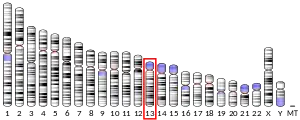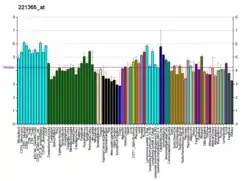| MLNR | |||||||||||||||||||||||||||||||||||||||||||||||||||
|---|---|---|---|---|---|---|---|---|---|---|---|---|---|---|---|---|---|---|---|---|---|---|---|---|---|---|---|---|---|---|---|---|---|---|---|---|---|---|---|---|---|---|---|---|---|---|---|---|---|---|---|
| Identifiers | |||||||||||||||||||||||||||||||||||||||||||||||||||
| Aliases | MLNR, GPR38, MTLR1, motilin receptor | ||||||||||||||||||||||||||||||||||||||||||||||||||
| External IDs | OMIM: 602885 HomoloGene: 74398 GeneCards: MLNR | ||||||||||||||||||||||||||||||||||||||||||||||||||
| |||||||||||||||||||||||||||||||||||||||||||||||||||
| |||||||||||||||||||||||||||||||||||||||||||||||||||
| |||||||||||||||||||||||||||||||||||||||||||||||||||
| |||||||||||||||||||||||||||||||||||||||||||||||||||
| Wikidata | |||||||||||||||||||||||||||||||||||||||||||||||||||
| |||||||||||||||||||||||||||||||||||||||||||||||||||
Motilin receptor is a G protein-coupled receptor (previously GPCR38)[3][4][5] that binds motilin.[6][7] It was first cloned in 1999 by Merck Laboratories.[8] and scientists have since been searching for compounds to modify its behavior.[9]
The primary structure of the motilin receptor consists of 412 amino acids,[8] while its tertiary structure resembles a golf club.[10] The protein C-terminal protein protects from enzymatic degradation, while the N-terminal is essential for binding.[10]
Function
The primary function of the motilin receptor is to contract gastric smooth muscle during phase III of the migrating motor complex (MMC).[8] In this final phase of the MMC, N-type motilin receptors in the distal antral pump of the stomach are activated.[11] This causes contraction of the gastric smooth muscle, sieving food into the small intestine, and priming the stomach for the next meal.[12]
Motilin
Motilin is an intestinal peptide that stimulates the contraction of gastric smooth muscle via the motilin receptor.[8] It is produced by enteroendocrine cells in the proximal small intestine[3][13] and secreted cyclically.[14] Motilin mimetics could be used to increase gastric motility in patients with gastroparesis e.g., constipation-predominant irritable bowel syndrome.[15] However, none of the candidate drugs that have been tested so far have made it to market.[4][16]
References
- 1 2 3 GRCh38: Ensembl release 89: ENSG00000102539 - Ensembl, May 2017
- ↑ "Human PubMed Reference:". National Center for Biotechnology Information, U.S. National Library of Medicine.
- 1 2 Gomez GA, Englander EW, Greeley GH (January 2012). "Chapter 7 - Postpyloric Gastrointestinal Peptides". In Johnson LR, Ghishan FK, Kaunitz JD, Merchant JL (eds.). Physiology of the Gastrointestinal Tract (Fifth ed.). Boston: Academic Press. pp. 155–198. doi:10.1016/B978-0-12-382026-6.00007-5. ISBN 978-0-12-382026-6.
- 1 2 Puckrin Z (February 2023). "Everything you need to know about the motilin receptor". www.reprocell.com. Retrieved 2023-02-24.
- ↑ Westaway SM, Sanger GJ (2009). "The identification of and rationale for drugs which act at the motilin receptor". Progress in Medicinal Chemistry. 48: 31–80. doi:10.1016/s0079-6468(09)04802-4. ISBN 978-0-444-53358-6. PMID 21544957.
- ↑ Depoortere I (2001). "Motilin and motilin receptors: characterization and functional significance". Verhandelingen - Koninklijke Academie voor Geneeskunde van Belgie. 63 (6): 511–529. PMID 11813507.
- ↑ Yang X, Dong L, Yang H (September 2006). "[Evidence for the presence of motilin receptor and a study on the mechanism of motilin induced Ca2+ signaling in rat myenteric neurons]". Sichuan da Xue Xue Bao. Yi Xue Ban = Journal of Sichuan University. Medical Science Edition (in Chinese). 37 (5): 683–686. PMID 17037727.
- 1 2 3 4 Poitras P (2013). "Chapter 170 - Motilin". Handbook of Biologically Active Peptides (Second ed.). San Diego, CA: Academic Press. pp. 1257–1264. doi:10.1016/B978-0-12-385095-9.00170-6. ISBN 978-0-12-385095-9.
- ↑ Leming S, Broad J, Cozens SJ, Otterson M, Winchester W, Lee K, et al. (October 2011). "GSK962040: a small molecule motilin receptor agonist which increases gastrointestinal motility in conscious dogs". Neurogastroenterology and Motility. 23 (10): 958–e410. doi:10.1111/j.1365-2982.2011.01770.x. PMID 21895874. S2CID 21813655.
- 1 2 Kaiya H (January 2021). "Chapter 30 - Ghrelin-motilin family". In Ando H, Ukena K, Nagata S (eds.). Handbook of Hormones (Second ed.). San Diego: Academic Press. pp. 317–319. doi:10.1016/B978-0-12-820649-2.00082-6. ISBN 978-0-12-820649-2. S2CID 242138545.
- ↑ Surjanhata BC, Kuo B (January 2014). "Gastrointestinal Motility and Enteric Neuroscience in Health and Disease". Reference Module in Biomedical Sciences. Elsevier. doi:10.1016/B978-0-12-801238-3.00051-9. ISBN 978-0-12-801238-3.
- ↑ Taheri S, Ghatei MA, Bloom SR (January 2010). "Chapter 152 - Gastrointestinal Hormones and Tumor Syndromes". In Jameson JL, De Groot LJ (eds.). Endocrinology (Sixth ed.). Philadelphia: W.B. Saunders. pp. 2759–2773. doi:10.1016/B978-1-4160-5583-9.00152-0. ISBN 978-1-4160-5583-9.
- ↑ Vella A (January 2016). "Chapter 38 - Gastrointestinal Hormones and Gut Endocrine Tumors". In Melmed S, Polonsky KS, Larsen PR, Kronenberg HM (eds.). Williams Textbook of Endocrinology (Thirteenth ed.). Philadelphia: Elsevier. pp. 1701–1722. doi:10.1016/B978-0-323-29738-7.00038-1. ISBN 978-0-323-29738-7.
- ↑ Shim J, Yu R (2020-01-01). "Chapter 7 - Gut Hormones in Pregnancy and Lactation". In Kovacs CS, Deal CL (eds.). Maternal-Fetal and Neonatal Endocrinology. Academic Press. pp. 91–99. doi:10.1016/B978-0-12-814823-5.00007-6. ISBN 978-0-12-814823-5. S2CID 208557201.
- ↑ de Villiers WJ (April 2003). "Sleisenger and Fordtran's Gastrointestinal and Liver Disease: Pathophysiology/Diagnosis/Management—2 Volume Set, 7th Edition". Shock. 19 (4): 397–398. doi:10.1097/00024382-200304000-00021. ISSN 1540-0514.
- ↑ Lafferty R, O'Harte F, Irwin N, Flatt PR, Gault VA (2022). "Pharmacology of Gut Hormone Mimetics for Obesity and Diabetes". Reference Module in Biomedical Sciences. Elsevier. pp. 301–343. doi:10.1016/B978-0-12-820472-6.00035-9. ISBN 978-0-12-820876-2. S2CID 234190503. Retrieved 2023-02-24.
Further reading
- Smith RG, Leonard R, Bailey AR, Palyha O, Feighner S, Tan C, et al. (February 2001). "Growth hormone secretagogue receptor family members and ligands". Endocrine. 14 (1): 9–14. doi:10.1385/ENDO:14:1:009. PMID 11322507. S2CID 31807893.
- McKee KK, Tan CP, Palyha OC, Liu J, Feighner SD, Hreniuk DL, et al. (December 1997). "Cloning and characterization of two human G protein-coupled receptor genes (GPR38 and GPR39) related to the growth hormone secretagogue and neurotensin receptors". Genomics. 46 (3): 426–434. doi:10.1006/geno.1997.5069. PMID 9441746.
- Feighner SD, Tan CP, McKee KK, Palyha OC, Hreniuk DL, Pong SS, et al. (June 1999). "Receptor for motilin identified in the human gastrointestinal system". Science. 284 (5423): 2184–2188. doi:10.1126/science.284.5423.2184. PMID 10381885.
- Miller P, Roy A, St-Pierre S, Dagenais M, Lapointe R, Poitras P (January 2000). "Motilin receptors in the human antrum". American Journal of Physiology. Gastrointestinal and Liver Physiology. 278 (1): G18–G23. doi:10.1152/ajpgi.2000.278.1.G18. PMID 10644557. S2CID 41964250.
- Thielemans L, Depoortere I, Van Assche G, Bender E, Peeters TL (March 2001). "Demonstration of a functional motilin receptor in TE671 cells from human cerebellum". Brain Research. 895 (1–2): 119–128. doi:10.1016/S0006-8993(01)02055-8. PMID 11259768. S2CID 19864565.
- Coulie B, Matsuura B, Dong M, Hadac EM, Pinon DI, Feighner SD, et al. (September 2001). "Identification of peptide ligand-binding domains within the human motilin receptor using photoaffinity labeling". The Journal of Biological Chemistry. 276 (38): 35518–35522. doi:10.1074/jbc.M104489200. PMID 11461914.
- Thielemans L, Depoortere I, Vanden Broeck J, Peeters TL (May 2002). "The motilin pharmacophore in CHO cells expressing the human motilin receptor". Biochemical and Biophysical Research Communications. 293 (4): 1223–1227. doi:10.1016/S0006-291X(02)00356-X. PMID 12054506.
- Depoortere I, Thijs T, Thielemans L, Robberecht P, Peeters TL (May 2003). "Interaction of the growth hormone-releasing peptides ghrelin and growth hormone-releasing peptide-6 with the motilin receptor in the rabbit gastric antrum". The Journal of Pharmacology and Experimental Therapeutics. 305 (2): 660–667. doi:10.1124/jpet.102.047563. PMID 12606621. S2CID 2078474.
- Matsuura B, Dong M, Naik S, Miller LJ, Onji M (May 2006). "Differential contributions of motilin receptor extracellular domains for peptide and non-peptidyl agonist binding and activity". The Journal of Biological Chemistry. 281 (18): 12390–12396. doi:10.1074/jbc.M511921200. PMID 16531413.
External links
- "Motilin Receptors: Motilin". IUPHAR Database of Receptors and Ion Channels. International Union of Basic and Clinical Pharmacology.
- Motilin+receptor at the U.S. National Library of Medicine Medical Subject Headings (MeSH)


